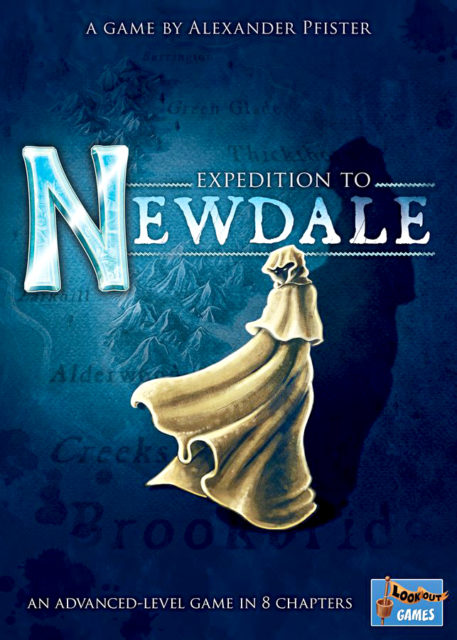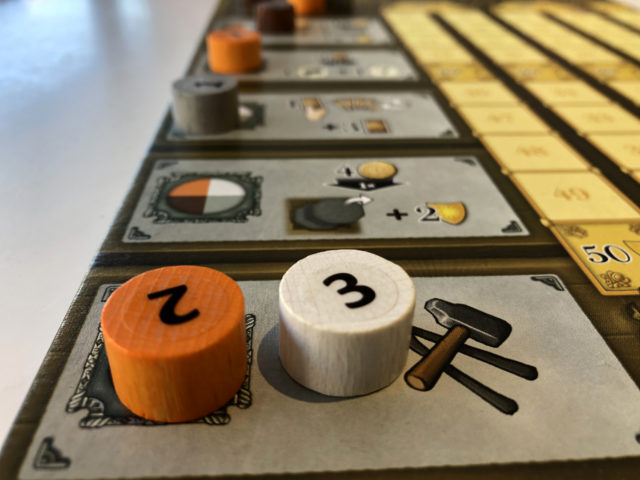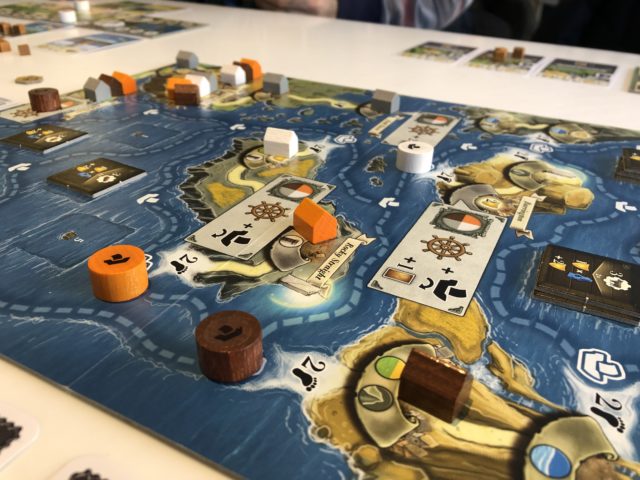I am unashamedly an Alexander Pfister fanboy at the moment. It’s been an interesting journey. I wasn’t a huge fan of Isle of Skye, I mean it was okay but didn’t really do it for me. Still haven’t played Mombasa–and on principle I tend to be leery of German designers plunking their games down in an exotic theme just for the sake of it. I did (and do) like Broom Service. But I never connected those games together as coming from the same guy; it was 2017’s Great Western Trail that actually put him on my radar.
I initially greeted GWT with backhanded compliments (see my review here), but in the years since it has grown on me. I still think it puts “a hat on a hat” mechanically and doesn’t make a ton of sense thematically. I don’t know, maybe it’s because it’s so popular with my gaming group, maybe it’s because it really is so satisfying to pull off a winning game (which I do rarely, believe me). In any case, I’m a convert, I bought the expansion, yada yada.
Interestingly (perhaps only to me) a month after semi-dissing GWT I gushed over Pfister’s Oh My Goods (here) as a game that packed a helluva lot of gameplay into a tiny box–and yet at that point I still hadn’t connected the dots.

I think it was Blackout: Hong Kong that made me sit up and really take notice of Pfister as a designer with Something to Say. Sure, it had some of the “mechanics overdrive” of GWT–a little bit deckbuilding, a little bit rondel, a little bit area control, a little bit pickup and deliver–but it had a strong and unique theme (even a bit on the nose once current events began to catch up with it) but even moreso, it had a mini-campaign where each scenario switched things up just enough to keep things interesting. Plus it was solo-friendly–not just solo-playable.
Then Maracaibo came to stores just as 2019 came to a close and really blew my mind. It had everything that B:HK had but in spades, and an even stronger mesh of theme and mechanic–even if its combat system was a bit mystifying at first (yes, it does make sense once you get to grips with it). Yes, it’s a bit of a beast to teach and the learning curve is steep. And yes, the campaign storyline is hardly legacy-style (some choices amount to “oops, you made the wrong decision and now you’re dead, so let’s rewind and take the other path”). Nonetheless, Maracaibo represents something almost unexplored–an attempt to create a true Euro with a narrative. Friedemann Friese’s Fable Games are the only other ones I can think of.
And now, Expedition to Newdale, which takes the push-your-luck and production-chaining core of Oh! My Goods! and campaignifies it. You don’t have to have played O!MG! to play EtN–and in fact there are a couple of things you have to unlearn to adapt. For one, you get to start with two actions a turn and can upgrade to a total of four (luxury!); for another instead of racing against the rising and falling sun every turn your production instead depends on how many workers of the correct colours get drawn from the bag every round.
But let me back up. Each one scenarios in EtN campaign lasts for seven rounds. As with Maracaibo you can play sequentially campaign-style or you can just pick the ones you like and play those. Each round starts with an event which also has some pre-printed workers on it in each of the four colours so you have some idea of what’s coming up.

Then players plan their turns, placing their action disks on various spaces. Once everyone is ready more workers are drawn from the bag so everyone can see whether their production plans pan out or not. All actions then fire off in numerical and turn order. Then everyone gets a chance to build something or grab more cards. Finally, certain buildings activate and the round ends.
As in O!MG! each card has multiple uses, the main one being a building which you place around your personal mat. Unlike O!MG! there is a hard limit of eight buildings. In order to produce on a building you have to place a worker next to it. Depending on which slot you place it in, you will have at least two production choices for it, which depend on whether you meet the worker requirements. You can play it safe and produce sloppily or you can try to push harder but risk producing nothing at all–except you can always chain-produce as long as you’ve placed a worker on the building and have the available resources (instead of workers) to input. In fact, if you plan things out well you can have a setup where you do all your production via chains and not have to worry about whether the right workers come out of the bag.
Whenever you build a building, you also get to place a settlement on the map. Each scenario plays out on one of six maps, and this geographic element obviously plays a large role in strategy, otherwise why bother having one? Building settlements can earn you bonus tiles and endgame points, as well as having scenario-specific consequences such as extra actions.
After seven rounds players add up points from private goals, scenario-specific rewards, military strength (the more the better), remaining goods, and points from buildings. Newdale adds in-game scoring, too, and passing certain point thresholds enables you to draw more cards, which is good because there’s no hand-limit and cards-in-hand is a tighter resource here than in O!MG!

I haven’t played all the scenarios yet but I can vouch for the fact that each one tweaks the formula in interesting and different ways, which gives you lots of variety for your buck. But you have to like the core gameplay to enjoy any of them.
As in Maracaibo the solo play is excellent, and as in Maracaibo the narrative thread is not very compelling. I admit it. You can easily enjoy the game without it. Pfister and Friese may not be the guys to perfect the “legacy” Euro, but at least they’re trying something new. Imperfect as Expedition to Newdale may be, his recent games in my opinion put Pfister at the very forefront of designers. What do those of you who’ve tried them out think?
Comments
No comments yet! Be the first!